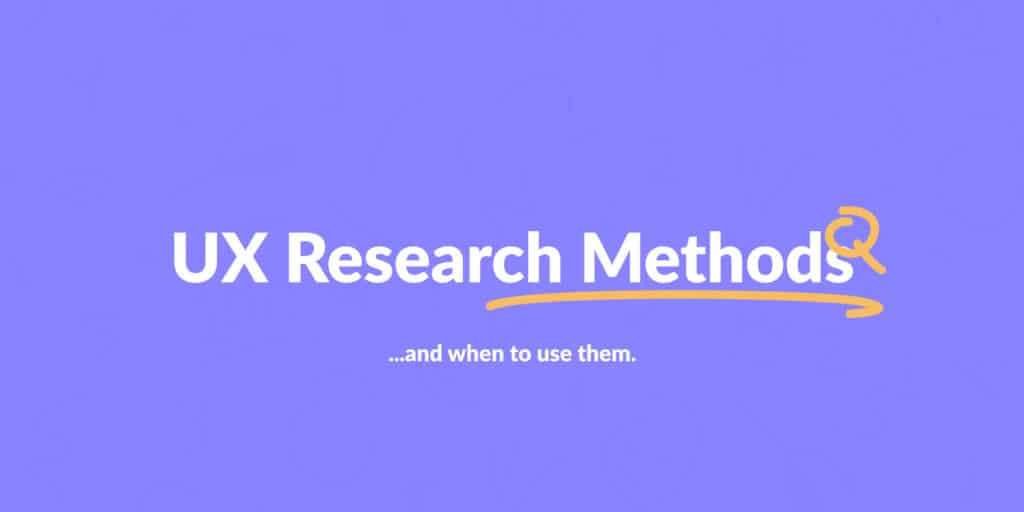👋 Great designs start with great feedback. That’s what Workflow is built for. Start today.
There are so many UX research methods to choose from. Which one do you pick before you start your new project? And why? Let’s take a look at a clear overview of UX research methods to help you choose the one you need.
- Updated on January 20, 2023

In this article, we will create a list of the most commonly used UX research methods. After that, I will divide them into groups to help you better understand all techniques you can use in UX research. It is also a great way to learn UX if that’s what you want.
I’ll also add pros, cons, and pointers on when and why to use a particular UX research method within the larger UX design project. And finally, make sure to check out my UX research methods cheat sheet at the end of the post.
Table of Contents
UX research methods
Given the enormous number of possible UX research methods, I’ve made an overview to help you have your pick. As it turns out, you can place every UX research method on a chart with quantitative and qualitative techniques on the y-axis and explore and validate on the x-axis.

Let’s start with an overview of each category, its place within design thinking, and the UX research methods you’ll find within that category.
Quantitative UX research
Research methods in this category are all about numbers and gathering lots of data. Therefore, you use quantitative research mainly at the start of your design thinking process to get your initial insights and understand the business goals and user needs.
In practice, it means that you ask a lot of people a lot of questions. You can do this rather quickly and without too much effort. However, the results will also remain superficial.
One of the most famous examples of quantitative UX research methods is the (online) questionnaire. I’m sure you’ve had to execute a questionnaire during one of your UX courses at some point. As you’ve probably seen, you can get a lot of data from these questionnaires. To finish this section, here’s a list of other quantitative UX research methods.
- (Online) questionnaires
- A/B testing
- Market analysis
Pros and cons
For quantitative UX research, the biggest pro is the speed and scope you can reach. Without too much effort, you can ask a lot of people a lot of questions. It is a great way to get started.
The con is that your results will help you get started but not more. As a result, your data will remain superficial, and you will have to dig deeper to get more valuable insights.
Qualitative UX research
Next up is qualitative UX research. Let’s say you have gathered a lot of data during the initial research phase of your design thinking project. After carefully analyzing your data, you find several interesting views, insights, and user needs.
Because of this, you want to take a deep dive into your new insights to do further research. That’s where qualitative UX research methods come into play. Instead of big superficial data, the techniques found in this category are all about interacting with a few people at a deeper level.
You could, for example, organize user interviews. In UX research, you can do individual user and group interviews.
The advantage of group interviews is time management. When you have limited time and budget for your project, it will save lots and lots of time.
In addition, if you put users with a different perspective in the same room, you will get a lot of valuable insights if you let them have a discussion. Then, all you have to do is facilitate that discussion to ensure it doesn’t go off the rails.
Individual user interviews can sometimes be perceived as an examination by the participant. Group interviews are less stressful for participants since they are not alone in the room.
And finally, here’s a list of other qualitative UX research methods.
- Co-create methods like workshops and online collaboration sessions.
- User interviews
- Group discussions
- User diary
- Storyboarding
- Card sorting
Pros and cons
For qualitative UX research, the pros and cons are the opposites of quantitative research methods.
It means that the individual and small group nature of these research methods will take more time to prepare and execute, but the insights will be more valuable.
Exploring and validating UX research methods
You can divide both research categories mentioned above into explorative and validation methods.
UX research methods in the first half of your design thinking projects are usually quantitative. That half of your project is your explorative phase. It means that most quantitative research methods are explorative as well. Another word for these techniques is generative UX research.
The second phase of design thinking, where you create and validate concepts, mainly uses qualitative research methods. However, these still fall in the explorative category.
Only a few ways of doing UX research are a part of the validating category. These are validation testing, guerrilla testing, and user testing.
How to pick the right UX research method
Picking the right UX research method starts with understanding your UX project, what it needs, and how far along you are within the project. You start with a UX project briefing before you start the project.
Such a UX project briefing is when you ask a lot of questions and then proceed to discuss the scope of the project and the expectations of your stakeholders.
With experience, you’ll learn how to recognize the UX method needed at any given point of a UX project. Even more so, you will even start to see that not every question needs a full-on research approach.
In some cases, you can answer a small question based on your expertise as a UX designer. For example, I once got a question about a sign-up form within a bigger user flow. Should we put all questions on one screen or have a one-question-per-screen design solution?
It is a solid question that you can easily spend hours on to find a solution. But does it need UX research? It seems so, but I wouldn’t do that right away. Here’s why.
First of all, this issue seems bigger than just one project. How you present a sign-up form is not unique to your project. Use existing design patterns or a design system to find a solution that works.
In addition, there are hardly any projects with the budget to do comprehensive UX research for every step of the user flow. So choose your battles carefully!
UX research methods cheat sheet
But when to use which UX research method? This brings us to the UX research methods cheat sheet.
There’s so much info on different research categories, right? And I haven’t even discussed all the ways you could use UX research as a designer.
To help you out, I’ve created a UX research methods cheat sheet for you to use in your next project. It contains a list of UX research methods, a summary of what they are, and when to apply them. Download it for free here.
How to present your UX research
The best way to present your UX research is by creating a presentation where you introduce your stakeholders to the initial research questions, the methods applied, and your insights.
Sometimes, you can also mention the next steps and what you will do with the insights.
Let’s discuss that presentation structure some more. I assume that there are people in the audience that haven’t seen your work before. That’s why you start with the UX research question. But, even for the people that know your work, this is a good reminder of why you’re doing your research.
Up next is your process. It is a natural segue to go from question to how you’re going to answer that question. Mention your UX research methods here, but keep it brief.
Finally, the insights and results of your UX research. That’s why people are here. Mention what came out of your research.
- User pain points
- Design challenges
- Customer journey
One thing that always works very well is to include a user quote. Nothing hits harder than a customer that says on record that it was very difficult or impossible to use your product.
Should you use personas
You only need to use a persona in UX research when you want to present hours of research in an easy-to-understand way to stakeholders that weren’t present for most of the design thinking project.
It means that a user persona isn’t a deliverable in and of itself. However, when you do use a persona, make sure to focus on user pain points and needs. Stay away from fake names and hobbies outside of the project scope. It doesn’t matter for the project.
Summary
That’s it for UX research methods and when to use them. There are so many ways to find user insights and use them to create a fantastic product.
In short, you can divide UX research methods into quantitative and qualitative research. Quantitative research is a quick way to get started, while qualitative research takes more time but gets you more valuable results.
In most projects, you start with quantitative research and use the initial insights to select a qualitative research method after that.
Check out the UX research methods cheat sheet included in this post. It will help you pick the technique that is right for you within your current project.
By the way, if you’re looking for more UX research help, I can recommend to watch the recording of a talk I did for UXPressia. I’ve embedded it just above.
👋 Turn good design to great design, with feedback you actually need. Get it on Workflow.

About the author
Hi! I'm Nick Groeneveld, a senior designer from the Netherlands with experience in UX, visual design, and research. I'm a UX coach that supports other designers and have completed design projects in finance, tech, and the public sector.
☎️ Book a 1:1 mentor meeting or let's connect on LinkedIn and Twitter.



